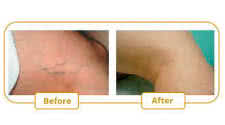Spider Veins: Injection Therapy Skin Vein Laser Treatment

Advanced Physical and Overall Wellness Sciences & Current Research
Spider veins - broken capillaries that leave a road map of red and purple lines on your skin - can ruin the looks of a great pair of legs. Although they're primarily a cosmetic problem, not a medical one, spider veins afflict about 40% of women and 10% of men.
Once they're there, exercise and good nutrition won't get rid of them. But Sclerotherapy can. Sclero what? Sclerotherapy, a method of treating varicose veins and spider veins. Refinements in this traditional treatment promise faster, more effective and less painful relief. And
laser therapy, still in its infancy, may someday replace the traditional treatment. But let's start at the beginning: Spider and varicose veins are similar hut not related. Both are caused by "extra" blood in the legs.
In the case of varicose veins, they are caused by rerouting of blood from the major leg vein, the saphenous vein, to other smaller veins. (MI veins in the body carry blood to the heart - arteries carry blood away from the heart, for use throughout the body.) When the valves of the
saphenous veins are weakened by age, genetics, pregnancy, too much standing or sitting, too little exercise, etc., these veins cannot return to the heart all the blood that was delivered to the legs. The result is too much blood in the legs, and smaller veins must handle the flow.
Ill-equipped to handle the excess, the veins bulge under the pressure. The result is varicose veins.
Spider veins are close to the skirfs surface, also bulging because of extra blood. But unlike varicose veins, which are beneath the skin, spider veins are "tiny capillaries on the surface of the skin," explains SM. Green- stone, MD, vascular surgeon in Encino, California, Spider
veins are not the result of rerouted blood - they just appear. "We don't really know why," says Greenstone.
They just do, but one factor seems to be heredity - if your mom's got 'em, you probably will too. What's more, pregnancy often leaves these unsightly traces because heightened estrogen levels during pregnancy weaken vein walls. (Not to mention the pressure on the legs from additional
weight.) Birth control pills, with their estrogen-raising effect,can also induce spider veins. Athletes are at no special risk unless they have a family history of varicose and spider veins. Genetics is the key.
All a woman can do is keep a keen watch and then start looking into cosmetic surgery. The oldest treatment for varicose veins is surgery, called "vein stripping." Here, the defective valves of the saphenous veins are surgically removed, leaving scars where the bulging veins once
were. Even today when varicose veins are larger than 3-4 millimeters in diameter, surgery is the only effective option.
INJECTTON THERAPY
But today, most women can undergo a treatment called Sclerotherapy for varicose and spider veins. A chemical solution (once saline-based, but now salt free for less pain) is injected into the vein, causing it to shrivel. As the injection takes place, Greenstone explains, the doctor must apply pressure to the spider vein. "With compression, the vein walls are closed off and it heals closed," he says. Compression continues for 2-3 weeks while the patient wears elastic stockings or a bandage to assure the complete closure of the veins. Then she wears them "as a preventative measure when she's on her Feet a lot," the doctor adds.Sclerotherapy works, inasmuch as the veins disappear, but only after weeks of follow-up treatment and with no guarantee of permanent removal. Side effects can include swollen or bruised legs, freckling or itching. Though they are rare, allergic reactions are possible. According to Stephen Friedman, MD, clinical assistant professor at the University of California, Los Angeles, Sclerotherapy is "virtually painless" because solutions like aethoxysclerol and SEW are replacing older saline-based solutions.
Greenstone says: "Pigmentation is probably the most common side effect and unfortunately it does not go away It's a trade-off." You trade slight skin discoloration for spider veins, a good trade for many people. The cost for one Sclerotherapy session, about 4-5 spider vein clusters depending on their size, is about $100. The effectiveness of Sclerotherapy for spider veins is not absolute. Greenstone cites a 10% satisfaction rate.
LASER TREATMENT
On the vein treatment horizon is laser therapy, whose proponents promise a high- tech solution to Sclerotherapy. The laser emits an intense, concentrated beam of light that dissolves the inflicted area. With the development of the Pump Dye Laser (which also goes by the name of a Tunable Dye Laser), the laser can he fine-tuned to treat a variety of veins, from the smallest veins around the eyes to the largest cluster on the thigh. Proponents also describe laser therapy as painless, each zap lasting a fraction of a second. And because it is so fast there is no time for Zinc is another mineral that is marginal in the vegetarian diet.Supplementation helps, but it's not that simple. It requires intricate networking of properly proportioned nutrients to work correctly. Arid if you stay on a strict vegetarian diet, you'll need extensive information on amino acids, how they complement (complete) each other (what one nonmeat food lacks, another has), and how they interact best with other nutrients, as well as a good working knowledge of nutrition and natural foods.
Your best bet, though, is to incorporate some animal protein in your diet. MI have seen, many vegetarians do end up adding some chicken or fish back into their diets and report that they feel all the better for it.